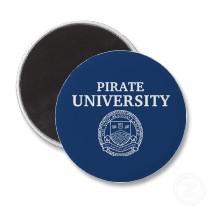
Earlier this week, we got our first glimpse of the Kindle DX, Amazon’s upcoming E-book reader that has taken the original Kindle’s nearly prohibitive $359 price tag and bumped it up to an even more exorbitant $489 for good measure. Granted, the DX has one major improvement: a bigger screen that makes it suitable for textbooks, professional journal articles, and even newspapers. I’ve spent the last few days mulling over the future prospects of the new device, and up until a few hours ago my forecast was looking pretty grim. But then a lightbulb went off over my head: pirates are going to save the Kindle DX.
But before I get to that, let’s address why the Kindle DX is poised to fail.
The Newspaper Strategy
Three major newspapers have banded together for an experimental trial run on the Kindle DX, offering cheaper long-term subscriptions to customers in return for the fact that their distribution costs will be next to nothing. The newspaper angle might be attractive for a few people, but I’m not convinced that it’s actually going to sell many Kindle DX’s – at least, not without the newspapers subsidizing the device’s cost as part of a subscription plan. Over $500 after taxes, plus paying for the newspaper subscriptions themselves, for convenient access to content that is already available for free online? I just don’t see it happening.
Kindle DX As A Textbook Reader

The other big marketing angle for Amazon is that the Kindle DX is the ultimate textbook reader. This sounds great in principle: students won’t have to lug around massive tomes between classes, and their books may even be slightly cheaper to boot! Unfortunately, for anyone who has ever actually used a Kindle, it’s pretty clear that this isn’t going to be as amazing as it sounds. Sifting through an E-book looking for a certain passage or image when you don’t know its exact page number (some call it ‘random access’) is a strange and unnatural experience. The Kindle sort of makes up for this by offering text search, but this is only helpful if there’s a proper name or unusual vocab term that you can remember in the passage.
But the Kindle’s real weakness is its highlighting and annotation functionality. In a real book, you can mark up your textbook and make notes to yourself in the margins. The Kindle lets you highlight and take notes, but the interface is painful to use with any kind of frequency – E-ink doesn’t lend itself well to quick navigation, nor does the Kindle’s joystick/button interface. From a student’s perspective, the Kindle is badly in need of a touchscreen. And while some students may initially grab the Kindle DX as soon as it comes out for the ‘cool’ factor, practicality (and cost) will rule it out for most of them.
Unless..
Pirates To The Rescue

College textbooks are really expensive. As in, $300+ per quarter (a small fortune for someone with little to no income) for a set of books that you may only occasionally look at and will have no use for three months down the line. If you’re thrifty you can sell those books back to your school and get doubly screwed when they fork over a laughably small return. Selling them online through services like Chegg usually yields better results, but for whatever reason most students still don’t use them.
So why don’t these students, renowned pirates as they are, simply copy the books? Well, textbook piracy already exists. If you know where to look online, you can find many novels and textbooks scanned in their entirety as PDFs. But until now, pirated textbooks were more trouble than they were worth. Reading them on a computer screen is a pain for obvious reasons. The alternative, printing out hundreds of pages at a time, results in an unwieldly mess that also stands out like a sore thumb whenever you pull it out in class.
The Kindle DX changes that. Just find the book you want in PDF form, upload it to your Kindle over USB, and you’ve got a perfectly readable and convenient textbook. Sure, students will have to deal with the usability issues I raised above, like slow highlighting. But these books, frustrating as they might be, will be 100% free. That’s $300 per quarter in extra beer money. Most obstacles and morals fade quickly in the face of that much alcohol.
Now, this is an issue we’ve brought up before when the original Kindle came out, and it hasn’t really been a problem. But most of the books people have been buying up until now are available for a mere $9.99 from Amazon. For most people, the motivation simply isn’t there to figure out how to pirate a book. But when you’re faced with a price tag of around $70 per textbook there’s a far greater incentive to find a workaround. It’s easier to find pirated files on campus too – students will be surrounded by classmates using the exact same textbooks so there’s a better chance someone will have a pirated digital version. And there’s always the resident friendly geek down the hall ready to help with any tech support issues.
So the Kindle DX may wind up selling well to Amazon’s chagrin. Amazon is really in the business of selling ‘the blades’ – it cares more about selling books than it does about selling devices (this is why Amazon offers an E-book reader for the iPhone too). Then again, it might just work out for the company after all. Students may take the time to pirate expensive textbooks, shortchanging their publishers. But a New York Times Bestseller? Why, I’d save myself the trouble and just buy it for $9.99 off Amazon.